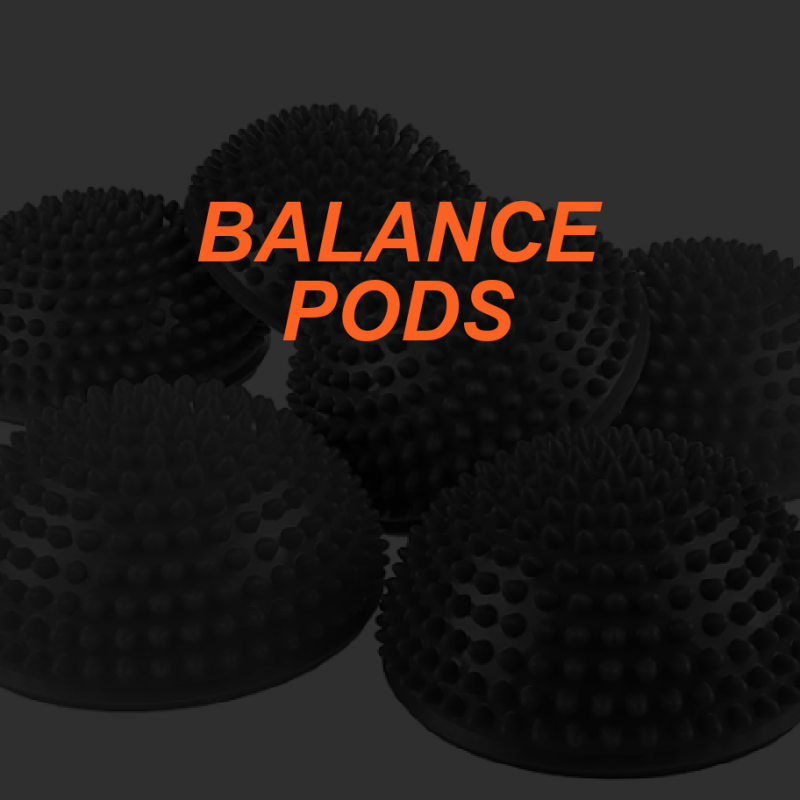
Balance training is an element every fitness coach can and should incorporate to a well-rounded program. After significant progress has been made, adding balance pods to personal training sessions might be just what your client needs. Read on to learn the what, why, and how.
What are balance pods?
The pods are smaller than the more common balance discs. They are round and about 6 inches by 4.5 in size. One style is flat on one side with a smooth arched opposite side; another style has one flat side with raised bumps on the other side (sometimes referred to as a hedgehog pod). The advantage of the hedgehog design is that the bumps make it easier to grip with hands or feet.
When your client stands on them, they’ll be about two inches or less off the floor – depending on your client’s weight – only a slight elevation.
Balance pods are relatively inexpensive, starting in the $20 range depending on the source. Use them in pairs or get several to use with various exercises. Their reasonable pricing and small size make them a convenient addition to any home gym or a convenient tool to carry with you for in-home clients. They can be packed in a gym bag or a suitcase for exercise on-the-go.
They come in lots of colors and can be used to designate circuits, starts, and stops, etc.
What are some reasons to incorporate them?
The pods challenge clients to use balance while performing exercises, without being very high off the ground (like a BOSU half ball for instance, which can intimidate some clients or create unnecessary difficulties at times). You can also use them for strength training to further activate muscle groups on a tougher, slightly elevated level. They also work well for yoga poses and stretching.
Most exercises that are performed with feet on the floor can also be performed on balance pods to create more of a challenge. Since the pods aren’t very high, risk of injury is decreased.
Use them with the flat side up or down to see what a difference the positioning makes. If you turn them flat side up, just be sure to spot your clients or have them mount the pods near a stable surface to acclimate without feeling unsafe.
Finally, incorporating balance pods are a great way to introduce something new to training sessions to break up monotony.
Benefits of balance pods
There are plenty of benefits to using the pods including but not limited to:
Stability and balance improvement
Better posture
Builds muscular strength
Firing up the core
Increasing confidence in client ability
Improved mobility
These benefits not only enable clients to function more effectively in daily activities and in their workouts, but are very effective in reducing joint and fall injuries.
Types of Exercises
When training a client who is new to this type of equipment, begin with a wall or railing nearby so they have something to hold onto. This will help them feel more stable until they are ready to go without. Depending on your client’s ability, he or she might be ready to go cold turkey without holding on right from the beginning, just be sure to stand close to spot them just in case.
Exercises utilizing these small pieces of equipment include:
- Simply standing and balancing
- Balancing on one foot
- Squats
- Staggering several of them for running drills
- Upper body weights while standing on them: bicep curls, hammers, shoulder presses, etc.
- Lying leg lifts over the pods
- Walking planks lifting hands over the pods
- Deadlifts
- Knee-ups
- Tibial stretches
- Calf stretches
- Walking in place
- Birddogs
- Bridge variations
- Lunges
- Airplanes
- Planks (with feet on them, hands on them in straight arm position, or using four of them with hands and feet on them)
References
https://sklz.com/balance-pods.html
https://www.primalplay.com/blog/8-benefits-of-balance-exercises
https://www.oprah.com/health/balance-pod-exercises-fitness-routine-instructions/all






